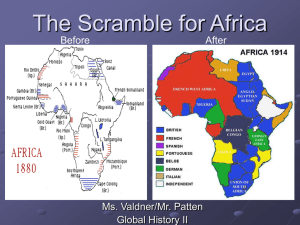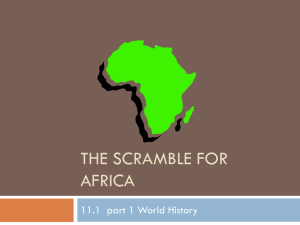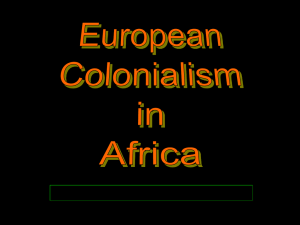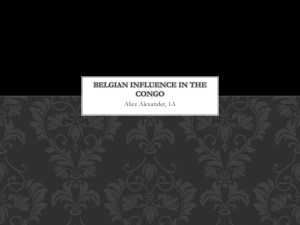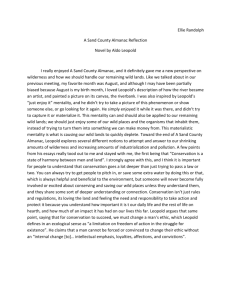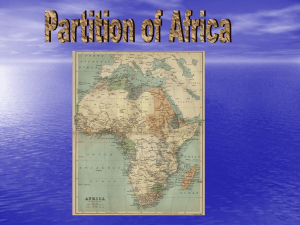British
advertisement
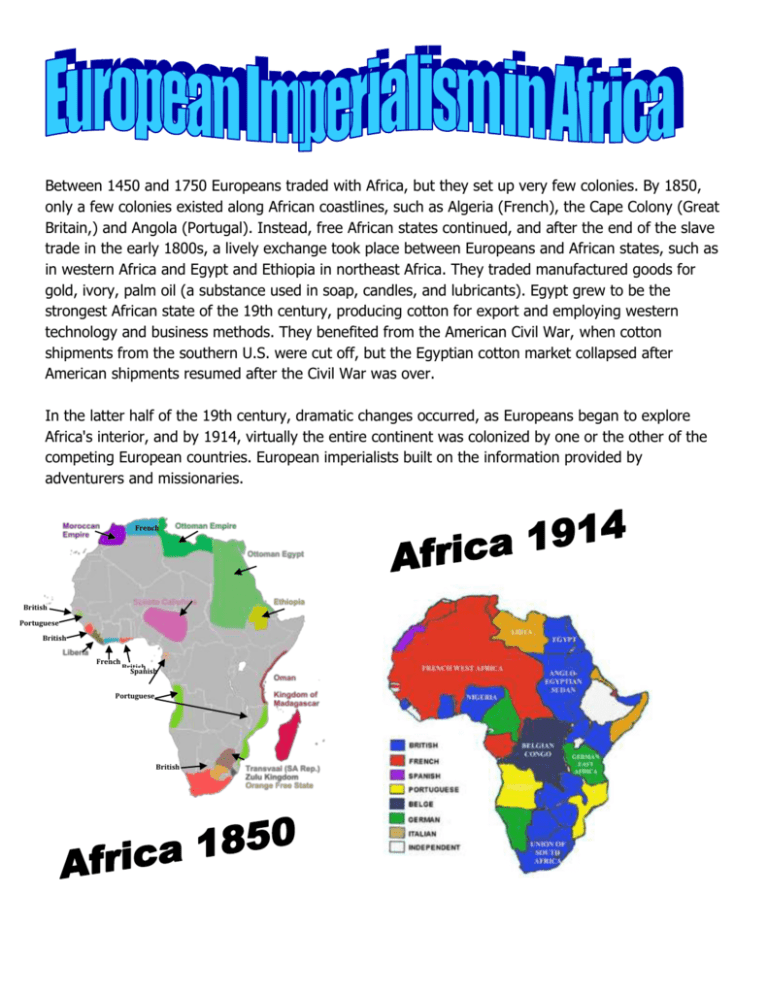
Between 1450 and 1750 Europeans traded with Africa, but they set up very few colonies. By 1850, only a few colonies existed along African coastlines, such as Algeria (French), the Cape Colony (Great Britain,) and Angola (Portugal). Instead, free African states continued, and after the end of the slave trade in the early 1800s, a lively exchange took place between Europeans and African states, such as in western Africa and Egypt and Ethiopia in northeast Africa. They traded manufactured goods for gold, ivory, palm oil (a substance used in soap, candles, and lubricants). Egypt grew to be the strongest African state of the 19th century, producing cotton for export and employing western technology and business methods. They benefited from the American Civil War, when cotton shipments from the southern U.S. were cut off, but the Egyptian cotton market collapsed after American shipments resumed after the Civil War was over. In the latter half of the 19th century, dramatic changes occurred, as Europeans began to explore Africa's interior, and by 1914, virtually the entire continent was colonized by one or the other of the competing European countries. European imperialists built on the information provided by adventurers and missionaries. French British Portuguese British French British Spanish Portuguese British The Belgian Congo & King Leopold The European colonization of Africa was one of the greatest and swiftest conquests in human history. In 1870 roughly 80 percent of Africa south of the Sahara Desert was governed by native kings, chiefs, and other rulers. By 1910 nearly the huge expanse of Africa had become European colonies, controlled by white settlers. The bloodiest single episode in Africa's colonization took place in the center of the continent in the large territory, known as the Congo. For centuries African slave dealers had raided parts of this area, selling their captives to American and European captains who sailed Africa's west coast, and to traders who took slaves to the Arab world from the continent's east coast. But heat, tropical diseases, and the huge rapids near the mouth of the Congo River on the Atlantic had long kept the Congo's interior a mystery to Europeans. From 1874 through 1877 the British explorer and journalist Henry Morton Stanley crossed Africa from east to west. For much of the journey he floated down the river, mapping its course for the first time and noting the many tributaries that, it turned out, comprised a network of navigable waterways more than 7,000 miles long. Stanley’s trip across the Congo basin was among the greatest feats of exploration and had an exceeding impact on history. As he headed back to England, Stanley was courted by King Leopold II of Belgium. Leopold, who had ascended to the throne in 1865, was a man of great charm, intelligence, but also of ruthlessness, and greed. Leopold was openly frustrated with inheriting the throne of such a small country, especially at a time in history when European kings were rapidly losing power to elected parliaments. He had long wanted a colonial empire, and in Stanley he saw someone who could secure it for him. The Belgian government of the day was not interested in colonies. But for Leopold this posed no problem; he would acquire his own. In 1879 Stanley returned to the Congo as Leopold's agent. He built outposts and a road around the river's rapids and, using small steamboats, he traveled up and down the great river and its tributaries. Combining gift-giving with a show of military force, he persuaded hundreds of illiterate African chiefs, most of whom had little idea of the terms of the agreement to which they were ostensibly acceding, to sign away their land to the king. Stanley made his way back to Europe with a sheaf of signed treaties in 1884. Meanwhile, Leopold had already begun the job of persuading first the United States and then all the major nations of Europe to recognize his claim. A master of public relations who portrayed himself as a great philanthropist, the king orchestrated successful lobbying campaigns in one country after another. The Berlin Conference, 1884 To avoid conflict with one another in Africa, European leaders, including King Leopold, met in Berlin, Germany. With little regard or representation for native Africans, the European powers set about carving up Africa. At the Berlin Conference, as it became known, the European powers set about carving up Africa according to the following guidelines: 1. Any sovereign power which wanted to claim any territory should inform the other powers “in order to ... make good any claim of their own.” 2. Any such annexation should be validated by effective occupation. 3. Treaties with African rulers were to be considered a valid title to sovereignty. King Leopold Takes the Congo Equipped with repeating rifles, cannons, and machine guns and fighting against Africans with only spears or antiquated muskets, King Leopold's 19,000-man army (black soldiers under white officers) gradually took control of the vast territory. From the start the regime was founded on forced labor. Hundreds of thousands of Africans were put to work as workers to carry the white men's goods, as cutters of the wood needed to fire steamboat boilers, and as laborers of all kinds. In the early years the main commodity Leopold sought was ivory. The Rubber Boom In the early 1890s, however, a larger source of wealth suddenly loomed. The invention of the inflatable bicycle tire, followed soon by that of the automobile tire, triggered an enormous boom in rubber. Throughout the world's tropics people rushed to establish rubber plantations. But new rubber trees often require fifteen years of growth before they can be tapped. During that window of time those who profited were the people who owned land where rubber grew wild. No one owned more land like this than King Leopold II, for equatorial rain forest, dotted with wild rubber vines, comprised half of his Congo state. The king's colonial officials quickly set up a brutal but effective system for harvesting wild rubber. A detachment of soldiers would march into an African village and seize the women as hostages. To secure their wives' release, the men would have to disperse into the rain forest to collect the sap of wild rubber vines. As the vines near a village were often drained dry, the men would sometimes have to walk for days to find areas where they could gather their monthly quota of rubber. As rubber prices soared, so did the quotas. Discipline was harsh; reluctant military conscripts, disobedient workers, and villagers who failed to gather enough rubber all fell victim to the notorious chicotte, a whip made of sun-dried hippopotamus hide with razor-sharp edges. A hundred lashes of the chicotte, a not infrequent punishment, could be fatal. Army officers and colonial officials earned bonuses based on the amount of rubber collected in areas under their control. These were an incentive for ruthless, devastating plunder. Many women hostages were beaten and a significant number starved to death. Male rubber gatherers often died from exhaustion. And under such circumstances people tended to stop having children, so the birthrate plummeted as a result. With most able-bodied adult prisoners working as forced laborers for several weeks out of each month, villages had few people who could plant and harvest food, or go hunting or fishing, and famine soon spread. Furthermore, huge, uncounted numbers of Congolese fled the forced labor regime, but the only refuge to which they could escape was the depths of the rain forest, where there was little food and no shelter; travelers would discover their bones years later. Tens, possibly hundreds, of thousands of Africans also died in two decades' worth of unsuccessful uprisings against the king's regime. An even greater toll was taken by disease: various lung and intestinal diseases, tuberculosis, smallpox, etc. The great population movements caused by the colonial regime brought these illnesses into areas where people had not built up immunities to them, and many would have died even under a government far less brutal than Leopold's. However, disease of any kind always takes a far greater toll on a traumatized, half-starving population, with many people already in flight as refugees. In two ways the Congo's rubber boom had lasting impact beyond the territory itself. First, the system of exploitation established there became a model for colonial rule in other parts of central Africa. Many of the surrounding colonies also had rain forests rich in wild rubber: the Portuguese-controlled northern Angola, the Cameroons under the Germans, and the French Congo, part of French Equatorial Africa, across the Congo River. Seeing what profits Leopold was reaping from forced labor, officials in these colonies soon adopted exactly the same system including women hostages, forced male labor, and the chicotteith equally fatal consequences. The events in King Leopold's Congo also rippled beyond its borders in a more positive way: They gave birth to the twentieth century's first great international human rights movement. The movement, in fact, eventually forced Leopold to relinquish his private ownership of the Congo to the Belgian state in 1908. By that point he had made a huge profit from the territory, conservatively estimated as the equivalent of more than $1.1 billion in early twenty-first century terms. Death Toll While numbers vary, some historians estimate that the overall death toll of the brutality of Leopold’s wrath are around 11.5 million, and a Congolese historian writing in 1998, Isidore Ndaywel è Nziem, estimates the loss at roughly 13 million. Humankind will never know even the approximate toll with any certainty, but beyond any doubt what happened in the Congo was one of the great catastrophes of modern times. Please read the article and then answer the following comprehension questions. 1. Describe the way in which Africa changed between 1850 and the start of World War I in 1914. 2. What relationship did Africa have with Europe and the US during the 19th century? 3. What area of Africa experienced the bloodiest display of European colonization? 4. What was this region a “mystery” to Europeans for so long? 5. How did Henry Morton Stanley contribute to the “demystification” of Africa? 6. Why did King Leopold of Belgium seek to secure colonies in Africa? 7. How was Stanley able to secure lands throughout Africa for King Leopold? 8. What occurred at the Berlin Conference? a. Define the term sovereign b. Define the term annexation 9. Why was rubber such a hot commodity in the late 19th century? 10. Summarize the way that King Leopold’s colonial officials organized the harvest of wild rubber. 11. Why did the birthrate of the Belgian Congo plummet? 12. Why did famine strike the natives in the Belgian Congo? 13. Why did so many natives die of disease? 14. What was the lasting impact of the rubber boom in Africa – one negative and one positive: 15. What is the estimated profit made by Leopold? What is the estimated death toll (low and high)?
